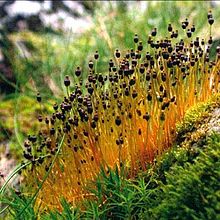| Splachnaceae Temporal range:
| |
|---|---|

| |
| Splachnum sphaericum | |
| Scientific classification | |
| Kingdom: | Plantae |
| Division: | Bryophyta |
| Class: | Bryopsida |
| Subclass: | Bryidae |
| Superorder: | Bryanae |
| Order: | Splachnales |
| Family: | Splachnaceae Grev. & Arn. |
| Genera | |
Splachnaceae is a family of mosses, containing around 70 species in 6 genera.[1] Around half of those species are entomophilous, using insects to disperse their spores, a characteristic found in no other seedless land plants.[2]
Many species in this family are coprophilous, growing exclusively on animal faeces or carrion.[3] For this reason, certain genera such as Splachnum Hedw. are often referred to as dung mosses.[3]
- ^ Bernard Goffinet (2012). "Splachnaceae". In Patrick M. McCarthy (ed.). Australian Mosses Online (PDF). Australian Biological Resources Study.
- ^ Bernard Goffinet, A. Jonathan Shaw & Cymon J. Cox (2004). "Phylogenetic inferences in the dung-moss family Splachnaceae from analyses of cpDNA sequence data and implications for the evolution of entomophily". American Journal of Botany. 91 (5): 748–759. doi:10.3732/ajb.91.5.748. PMID 21653429.
- ^ a b Marino, Paul; Raguso, Robert; Goffinet, Bernard (2009-01-01). "The ecology and evolution of fly dispersed dung mosses (Family Splachnaceae): Manipulating insect behaviour through odour and visual cues". Symbiosis. 47 (2): 61–76. doi:10.1007/BF03182289. ISSN 1878-7665. S2CID 36557683.